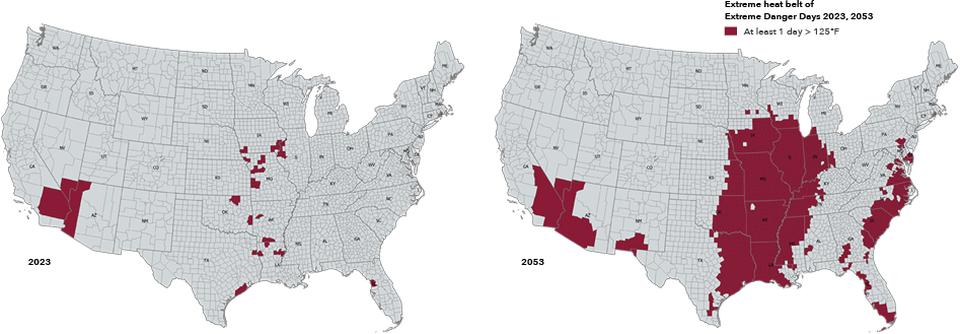Is an ‘Extreme Heat Belt’ Going to Wrap Itself Around the U.S.?

The First Street Foundation’s report “Hazardous Heat” identifies 50 counties expected to experience feel-like temperatures above 125°F in 2023. By 2053, an “extreme heat belt” will be prevalent across a large section of the country.
Graphic courtesy of First Street Foundation
Is it hot in here? Yes, and it’s fixing to get hotter more often – a lot hotter, according to a new report authored by the First Street Foundation. When you boil it all down, the non-profit research and technology group indicates not only is climate change a force to be reckoned with, but also a related “extreme heat belt” is building to turn up the pressure cooker across a huge chunk of the U.S. This might not be the biggest shock given recent historic heat wave events.
The Brooklyn, NY-based organization’s peer-reviewed extreme heat model, along with implications, are highlighted in its latest report titled “The Sixth National Risk Assessment: Hazardous Heat.” The comprehensive body of work identifies the impact of increasing temperatures at a property level, and how the frequency, duration, and intensity of “extremely hot” days will change over the next 30 years.
First Street Foundation’s analytical methodology combines high-resolution measurements of land surface temperatures, canopy cover, impervious surfaces, land cover, and proximity to water to calculate the current heat exposure, and then adjusts for future forecasted emissions scenarios.
The model highlights the local impacts of climate change by identifying the seven hottest days expected for any property this year, and then using that metric to calculate how many of those days would be experienced in 30 years.
The report points out the most severe shift in local temperatures will be in South Florida’s Miami-Dade County where the 7 hottest days (currently at a heat index of 103°F) will increase to 34 days at that same temperature by 2053.
Across the country, on average, the local hottest 7 days are expected to become the hottest 18 days by 2053. In the case of extreme heat, the model finds 50 counties (home to 8.1 million residents) expected to experience feel-like temperatures above 125°F in 2023, the highest category of the National Weather Services’ heat index. By 2053, 1,023 counties are expected to exceed this temperature, an area that is home to 107.6 million and covers a quarter of the U.S. land area. This emerging area, termed by the Foundation as the “Extreme Heat Belt,” stretches from northern Texas and Louisiana borders to Illinois, Indiana, and even up into Wisconsin.
“Increasing temperatures are broadly discussed as averages, but the focus should be on the extension of the extreme tail events expected in a given year,” says Matthew Eby, founder and CEO of First Street Foundation. “We need to be prepared for the inevitable.”
For further details, visit FirstStreet.org to download the full report and more.
What do you think of the findings in First Street Foundation’s report? Leave a reader comment below.









